|
|
|
 |
 |

 |
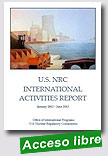 |
U.S. NRC International Activities Report - January 2012 – June 2013
United States Nuclear Regulatory Commission, 2013, 26 p.
Sixty years ago, President Dwight D. Eisenhower, in his “Atoms for Peace” speech before the United Nations General Assembly on December 8, 1953, was determined to transform the atom from a “scourge” into a benefit for humankind. Over time, his speech was followed by the creation of a multitude of peaceful atomic treaties, organizations, and programs, including the Atomic Energy Act of 1954, the International Atomic Energy |
Agency (IAEA), the Treaty on the Non-Proliferation of Nuclear Weapons, and finally, in 1975, the creation of the Nuclear Regulatory Commission (NRC) with its international programs.
Since signing the first bilateral cooperation arrangements in 1975, the main objective of the NRC’s international activities has been to promote and sustain commitments to nuclear safety and security in the United States and worldwide. The NRC’s robust program of multilateral and bilateral cooperation and assistance and international cooperative research, has greatly enhanced the effectiveness of the NRC’s regulatory policies and practices domestically. In turn, through increased interactions with foreign regulators and participation in various nuclear fora and meetings, the NRC garners tremendous respect and significantly advances the principles of good will and good regulation with our technical counterparts.
Extraído de:
https://www.nrc.gov/reading-rm/doc-collections/commission/tr/2013/ml13184a329-intl-activities-report-012012-062013.pdf
|
 |
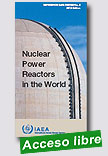 |
Nuclear Power Reactors in the World - 2013 Edition
IAEA Reference Data Series, 2013, 80 p.
This is the 33rd edition of Reference Data Series No.2, which presents the most recent reactor data available to the IAEA. It contains summarized information as of the end of 2012 on: power reactors operating, under construction, and shut down; and performance data on reactors operating in the IAEA Member States, as reported to the IAEA. The information is collected through designated national correspondents in the Member States and the data area used to maintain the IAEA's Power Reactor Information System (PRIS). |
Extraído de: http://www-pub.iaea.org/books/IAEABooks/10593/Nuclear-Power-Reactors-in-the-World-2013-Edition
|
 |
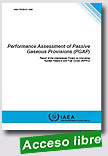 |
Performance Assessment of Passive Gaseous Provisions (PGAP)
IAEA TECDOC, 2013, 191 p.
The International Project on Innovative Nuclear Reactors and Fuel Cycle (INPRO) initiated a collaborative project to contribute to an international consensus on the definition of the reliability of passive systems that involves natural circulation, and a methodology to assess this reliability. Different reliability methodologies available in Member States were used to assess the performance and reliability of passive decay heat removal system of the French gas cooled fast reactor (GFR) design for |
various transients. This publication is the final report of this project and summarizes the results of the participants’ work concerning the evaluation of the performance and reliability of the passive decay heat removal system of the GFR design. The report also presents a unified definition of the reliability of thermal hydraulic passive system, and the possibility of unifying the features of the methodologies in order to develop a generic methodology.
Extraído de:
http://www-pub.iaea.org/books/IAEABooks/10363/Performance-Assessment-of-Passive-Gaseous-Provisions-PGAP |
 |
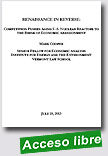 |
Although Wall Street analysts expressed concerns about the economic viability of the aging nuclear fleet in the U.S., the recent early retirements of four nuclear reactors has sent a shock wave through the industry. One purely economic retirement (Kewaunee, 1 reactor) and three based on the excessive cost of repairs (Crystal River, 1 reactor, and San Onofre, 2 reactors), in |
addition to the cancellation of five large uprates (Prairie Island, 1 reactor, LaSalle, 2 reactors, and Limerick, 2 rectors), four by the nation’s large nuclear utility, suggest a broad range of operational and economic problems.
These early retirements and decisions to forego uprates magnify the importance of the fact that the “nuclear renaissance” has failed to produce a new fleet of reactors in the U.S. With little chance that the cost of new reactors will become competitive with low carbon alternatives in the time frame relevant for old reactor retirement decisions, a great deal of attention will shift to the economics of keeping old reactors online, increasing their capacity and/or extending their lives.
The purpose of the paper is not to predict which reactors will be the next to retire, but explain why we should expect more early retirements. It does so by offering a systematic framework for evaluating the factors that place reactors at risk of early retirement.
Extraído de: http://216.30.191.148/071713%20VLS%20Cooper%20at%
20risk%20reactor%20report%20FINAL1.pdf
|
 |
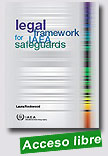 |
Legal Framework for IAEA Safeguards
IAEA, 2013, 32 p.
The legal framework for IAEA safeguards has evolved significantly since the Board of Governors first approved ad hoc safeguards arrangements in 1959. It is multifaceted, and consists of a number of elements, including: the Statute of the Agency; the undertakings of States in connection with supply arrangements and other treaties requiring verification; the basic safeguards documents; the safeguards instruments themselves, including safeguards agreements, protocols and |
subsidiary arrangements; and, finally, the decisions and practices of the Board of Governors. This publication provides a succinct, yet comprehensive, review of the current legal framework and its historical development. It introduces IAEA safeguards to the reader and describes the legal framework for their implementation.
Extraído de:
http://www-pub.iaea.org/books/IAEABooks/10388/Legal-Framework-for-IAEA-Safeguards
|
 |
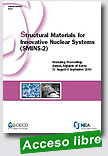 |
Structural Materials for Innovative Nuclear Systems (SMINS-2)
Workshop Proceedings, Daejon, Republic of Korea, 31 August-3 September 2010
Nuclear Energy Agency (NEA), 31/12/2012, 444 p.
Materials research is a field of growing relevance for innovative nuclear systems, such as Generation IV reactors, critical and sub-critical transmutation systems and fusion devices. For these different systems, structural materials are selected or developed taking into account the specificities of their foreseen operational environment. Since 2007, the OECD Nuclear Energy Agency |
(NEA) has begun organising a series of workshops on Structural Materials for Innovative Nuclear Systems (SMINS) in order to provide a forum to exchange information on current materials research programmes for different innovative nuclear systems. These proceedings include the papers of the second workshop (SMINS-2) which was held in Daejon, Republic of Korea on 31 August-3 September 2010, and hosted by the Korea Atomic Energy Research Institute (KAERI).
Extraído de:
http://www.oecdnea.org/tools/publication?query=
&div=&lang=&period=6m&sort=title&filter=1#p7089
|
 |
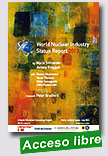
|
The World Nuclear Industry Status Report 2013
Mycle Schneider Consulting, July 2013, 141 p.
Two years after the Fukushima disaster started unfolding on 11 March 2011, its impact on the global nuclear industry has become increasingly visible. Global electricity generation from nuclear plants dropped by a historic 7 percent in 2012, adding to the record drop of 4 percent in 2011. This World Nuclear Industry Status Report 2013 (WNISR) provides a global overview of the history, the current status and the trends of nuclear power programs worldwide. |
Executive summary & conclusions | Low resolution | High resolution
Extraído de: http://www.worldnuclearreport.org/-2013-.html
|
 |
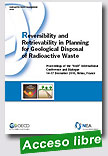 |
Reversibility and Retrievability in Planning for Geological Disposal of Radioactive Waste
Proceedings of the "R&R" International Conference and Dialogue, 14-17 December 2010, Reims, France
Nuclear Energy Agency (NEA), 31/12/2012, 236 p.
Deep geological repositories of radioactive waste are designed and licensed based on a model of long-term safety which does not require the active presence of man. During the period of stepwise development of such repositories, reversibility of decisions and retrievability of the waste are widely thought to be beneficial. Reversibility and retrievability are not requirements for |
long-term safety. They are instead about implementing a process that responds to ethical and precautionary obligations without compromising safety. How are the concepts of reversibility and retrievability understood in the various nuclear countries? How do they appear in national waste management legislation, regulation and operational programmes, and how can they be implemented?
The “R&R” project of the OECD Nuclear Energy Agency (NEA) culminated in an International Conference and Dialogue on Reversibility and Retrievability in December 2010. This open meeting brought together regulators, policy makers, elected officials, experts in social sciences, and representatives of civil society and stakeholder groups in addition to waste management professionnels. These proceedings include the texts of 50 presentations and the “International Retrievability Scale” – a tool to support dialogue with stakeholders and to help establish a common international framework.
Extraído de:
http://www.oecdnea.org/tools/publication?query=&div=
&lang=&period=6m&sort=title&filter=1#p7089
|
 |
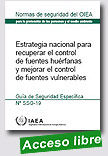 |
Estrategia Nacional para Recuperar el Control de Fuentes Huérfanas y Mejorar el Control de Fuentes Vulnerables
Colección de Normas de Seguridad del OIEA, 2013, 202 p.
El objetivo de la presente guía de seguridad consiste en proporcionar una metodología para formular una estrategia nacional destinada a recuperar el control de fuentes huérfanas y mejorar el de fuentes vulnerables, con el fin de
cumplir los requisitos de seguridad estipulados en las normas correspondientes de seguridad del OIEA [13, 14]. En la presente guía de seguridad se formulan recomendaciones e
|
indicaciones para evaluar de modo sistemático la situación nacional y formular y aplicar a partir de ahí una estrategia general con prioridades para lograr esos objetivos.
Extraído de:
http://www-pub.iaea.org/MTCD/Publications/PDF/Pub1510s_web.pdf
|
 |
|
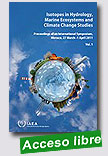
|
Isotopes in Hydrology, Marine Ecosystems and Climate Change Studies - Proceedings of the International Symposium Held in Monaco, 27 March - 1 April 2011
IAEA Proceedings Serie, 2013, 529 p.
This publication presents the proceedings of the latest IAEA symposium on isotopes in hydrology, marine ecosystems and climate change studies. At the symposium, five major topics were addressed through invited talks and oral presentations. These five sessions covered: the role of isotopes in understanding and modelling climate change, marine
|
ecosystems and the water cycle; carbon dioxide sequestration and related aspects of the carbon cycle, such as ocean acidification; isotopes and radionuclides in the marine environment, groundwater assessments for large aquifers; analytical methods and instrumentation for the application of isotopes in environmental, climate and hydrological studies. Leading scientists in the field of climate change and hydrology, as well as representatives from climate change and environmental bodies and organizations, exchanged their views and experience.
Vol. 1 | Vol. 2
Extraído de:
http://www-pub.iaea.org/books/IAEABooks/8890/Isotopes-in-Hydrology-Marine-Ecosystems-and-Climate-Change-Studies-Proceedings-of-the-International-Symposium-Held-in-Monaco-27-March-1-April-2011 |
| |
|
|
| |
| |
|
|
|
| |
|
|
|
| |
|
|
|
| |
|
|
|
|
|
